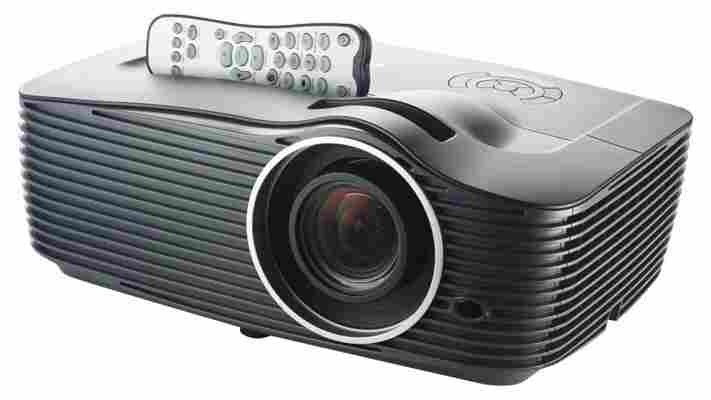It may be roughly the same price as the company's excellent GT1080 gaming projector, but the HD151X has a much larger lens and longer throw ratio, placing it firmly in Optoma’s home cinema range. With a huge throw ratio of 1.37:1 to 2.05:1, you can position the HD151X much further away from your projection screen (up to 10m) and still get a clear, crisp image. This is crucial if you need a projector to fill a large space, as the GT1080 only works up to a more coffee table-friendly 3.35m.
The HD151X also beats the GT1080 on ports, making it much more flexible. As well as one HDMI input, you’ll find a dual-link DVI-D input, two VGA inputs, an S-video port and a composite input. There’s also a VGA output, a 3.5mm headphone jack, a 3.5mm microphone port, two 3.5mm audio inputs for when you’re using the VGA or DVI-D inputs, a USB power port, a 12V trigger and an RS-232C port for home automation systems. Finally, there’s a 3D sync port for Optoma’s wireless 3D system and a USB service port for firmware updates.
The 20 per cent vertical lens shift is another welcome addition, as this makes it much easier to fill your projection screen without physically moving the projector. It’s rare to see a projector at this price with so much lens shift available (the BenQ W1070+, for instance, only has 5 per cent) and you don’t have to fiddle around with buttons on top of the projector to do it either; you can control it entirely through the projector’s menu system. You can also adjust the projector’s zoom using the menu, but there’s a manual zoom ring on top of the projector next to the focus ring as well if you prefer.
IMAGE QUALITY
The HD151X has a very bright lamp for a £650 projector, measuring 2,800 ANSI lumens. This is a fraction brighter than the similarly priced BenQ W1070+’s 2,300 ANSI lumen lamp, but each projector’s colour intensity was roughly the same. The HD151X’s main advantage is that dark night scenes were much easier to see when we had the lights turned on. For instance, we were able to pick out a much higher level of shadow detail in the dark forests of Pandora in Avatar than the W1070+, and areas of deep black on trees were full of highlights and visibly gnarled bark.
There are several pictures modes to choose from, including Cinema, Bright, Vivid, User, Reference and Game, but you’ll automatically be switched over to User if you start changing any of the settings. This means that it’s very easy to accidentally erase any previous User settings you might have painstakingly set up beforehand, but at least there are a decent number of settings available for tweaking the picture.
Basic controls include brightness, contrast, sharpness, colour and tint, while the advanced menu gives you access to noise control, gamma, Brilliant Colour, Dynamic Black, colour temperature, colour space and individual RGBCMYW colour controls for gain, saturation and hue. This puts it on par with the BenQ W1070+, so you won’t be at a disadvantage in terms of overall picture quality.
We found that Brilliant Colour and Dynamic Black didn’t make much of a difference to the projector’s overall picture quality, but adjusting the gamma settings is particularly useful for highlighting extra areas of darkness if your room proves too bright during the daytime.
There’s no frame interpolation, but the HD151X’s image processing is excellent, with long camera pans in Avatar appearing smooth and largely judder free. We didn’t really notice any rainbow effects either, which are common to DLP projectors and can make watching films rather uncomfortable if you’re susceptible to it. Other Optoma projectors we've tested recently have had much more noticeable rainbow effects, so we're pleased to see they are kept to a minimum here.

